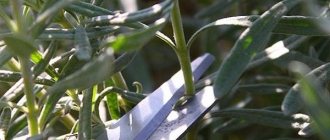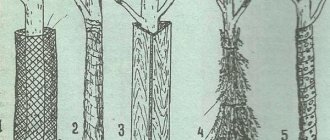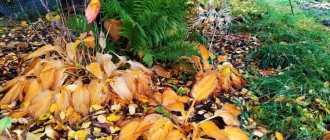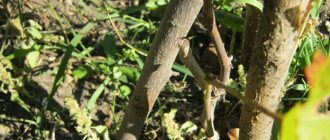Tree peony care in autumn, preparation for winter. Especially for readers of “Popular on Health,” I will consider how to properly end the season for a plant such as a tree peony - care in the fall, preparation for winter, what it involves. How to perform all the necessary manipulations so that this beautiful plant will delight gardeners with its stunning flowers next year?
Features of tree peony
Tree peony is a deciduous shrub whose height varies from 150 to 200 centimeters. Thick, erect shoots are colored pale brown. Unlike the herbaceous peony, the stems of such a plant do not wither in the autumn, but grow more and more every year, and over time the bush acquires a semi-spherical shape.
The ornamental, openwork leaves are double pinnate. The flowers are located at the ends of the stems and their diameter varies from 12 to 20 centimeters or more. Such flowers are double, semi-double and simple. They can be painted white, purple, yellow, pink, crimson, and are also available in two colors. With age, flowering becomes more abundant. The flowering of such a peony begins 2 weeks earlier than the herbaceous one, and its duration is 14–21 days. Such peonies are resistant to cold.
Botanical description
The plant is a deciduous shrub, reaching a height of one and a half or two meters. Stems are light brown, thick, erect. They do not die off every autumn, like the stems of the herbaceous peony, but grow every year, gradually turning the plant into a hemispherical bush. The leaves of the tree peony are openwork, double-pinnate, ornamental. The flowers are very large - from 12 cm in diameter to 20 cm, or even more - located at the ends of the shoots. They come in single, semi-double, double, and various colors - yellow, white, pink, purple, crimson, even two-color.
The older the bush gets, the more flowers bloom on it. The tree peony begins to bloom half a month earlier than the herbaceous peony and blooms for two to three weeks. Tree peonies are cold-resistant.
- Tips for caring for floribunda roses
Preparing a tree peony for winter
During the period of preparing the plant for winter, gardeners begin to think about how to preserve peonies in the winter, whether it is necessary to cover the tree peony for the winter and how to do it.
Latest articles about gardening
Salting cabbage in February 2021 according to the lunar calendar
How to treat pepper seeds with hydrogen peroxide before planting seedlings?
Treating pepper seeds with potassium permanganate before planting seedlings
In fact, opinions differ in the floriculture literature; some authors recommend covering peonies in the winter months, while others consider this unnecessary. In fact, peony is not as afraid of frost as early spring thaws, during which the peony buds, uncovered by snow or covered with material, can wake up, and, as a rule, frosts following a thaw can destroy the plant that has begun to grow. Therefore, the conclusion suggests itself that covering the peony for the winter is a completely unnecessary measure.
In order to cover a peony, in October you need to tie up the shoots, mulch the tree trunk with peat (humus), and with the onset of cold weather it is better to cover the plant with a hut of spruce branches, leaves, a thick layer of crushed bark, sawdust or just jute bags so that the tree can overwinter peony went well.
If we are talking about a herbaceous peony, after flowering its stems must be cut to a level of 5-7 cm above the ground and mulched in the same way as described above in the case of a woody peony. If you live in a very cold region, then shelter will be a good idea.
In principle, these are the main aspects that will help you properly care for peonies after flowering and prepare them well for wintering.
Pruning peonies after flowering
Pruning stems after flowering is one of the important measures for caring for plants. Most often, novice gardeners wonder: is it possible to prune them immediately after flowering and how exactly to do this? Our article will try to clarify all the unclear points regarding this procedure.
The main thing you need to know is the fact that for some time after flowering the bush cannot be touched. In this way, we give it the opportunity to accumulate strength and nutrients to form new buds.
Peculiarities
It is recommended to completely remove all faded buds for the first three years. However, do not rush to cut off the buds as they fade. It is worth waiting until the entire bush has bloomed, and only after that remove the bud along with part of the stem down to the first leaf. This procedure will ensure more abundant flowering next year (Figure 1).
Note: But, if you want to achieve not an increase in the number of flowers, but an increase in their size, the top buds should be left.
As for the foliage, cutting it off unless clearly necessary is not recommended, since the green mass plays an important role in the circulation of nutrients throughout the plant. In addition, cutting leaves can only be done in the fall in warm weather.
How and when to prune flowers correctly is shown in the video.
Rules
Although it is not recommended to trim each flower immediately after it has bloomed, it is worth making sure that faded and fallen petals do not cover the bush. Excess moisture collects under the layer of fallen petals, which causes the development of mold and rot.
Rules for pruning tree peony
There are some rules that will help answer the question of whether it is necessary to prune bushes after flowering, and how to do it correctly.
For the procedure to be successful, you need to do the following:
Start pruning for the winter after the first frost, when all the stems of the bush fall to the ground.
The stems of the plant should be cut almost to the root, leaving sprouts above the buds no more than 10 cm high.
The remaining root system must be carefully protected from the cold using humus or dry peat.
Pruning peonies in winter, spring and autumn
In autumn, peonies require special care, which will help the plants successfully withstand the cold season. When to prune peonies for the winter is a relevant question for all flower growers and owners of summer cottages. Proper and timely pruning will preserve the vital juices of the plant and prepare it for winter.
The features of spring pruning of tree and herbaceous varieties will be described in this article, and photos and videos will help novice gardeners carry out the procedure correctly.
How to cover a tree peony for the winter
According to experienced gardeners, insulating a tree peony for the winter is not at all difficult. First you need to sprinkle the tree trunk circle with peat, and with the onset of frost, you will only need a few spruce branches, from which you need to build something like a hut around it. To prevent the hut from falling apart, tie the branches with twine.
Alternatively, you can prepare oak leaves in advance and fill the frame built around the bush with them. It additionally needs to be covered from dampness.
Latest articles about gardening
How to feed currants in summer
How to feed currants in the fall
How to feed currants and gooseberries in spring?
The layer of peat with which you will sprinkle the ground around the bushes should be at least 10 cm. For northern regions, you can increase it to 15-20 cm. This warm shelter will not only save the plant, but will also provide the nutrients necessary for growth and development in the spring . Peonies covered in this way will bloom earlier and more abundantly, since peat and humus will become a good growth stimulator for plants.
Types and varieties of tree peonies with photos
The various varieties of such plants are based on several natural species, namely: yellow, Potanin, Lemoine and Delaway, which are directly related to the group of semi-shrub peonies. Most of the registered varieties of such plants grow in China. These varieties are divided into 3 groups:
Sino-European
The flowers are very large and double. They weigh a lot and therefore are drooping. Flowers can be painted in various shades from fuchsia to light pink.
Japanese
The flowers are not very large and light. They seem to hover above the bush.
Hybrid varieties
Created from Delaway peony and yellow peony, the most popular varieties are those with yellow flowers.
The most popular varieties:
Kiao Sisters
The pink inflorescences are painted in 2 colors, so one half is dark red and the other is creamy white. The flower reaches 16 centimeters in diameter.
Sapphire
The diameter of the light pink flowers with a dark crimson center is 18 centimeters. About 50 flowers can open on a bush at the same time.
Coral altar
The crown-shaped flowers are painted in 2 colors: white and salmon at the same time. In diameter they reach no more than 20 centimeters.
Green Jade
The shape of the flowers is very impressive and unique. It is a pale green bud.
Propagation of tree peony by seeds
Using seeds, you can not only propagate, but also get your own varieties of tree peonies, which will not be found in any garden. When propagating peony by seeds, you need to have time to collect them correctly and on time. To do this, two weeks after flowering, the seed pods are tied with gauze - this technique will allow you not to lose a single ripened seed. The seeds are collected when the boxes open and the seeds spill out into the gauze.
Tree peony seeds lose their viability quite quickly, so they are sown in the year of collection.
For sowing, prepare an ordinary plastic deep box (for example, for fruit) and a tray suitable in size. Prepare a soil mixture of peat and sand in a ratio of 2:1.
The collected seeds have a very hard shell that must be broken, i.e. perform scarification. For this I use two sheets of fine sandpaper. I put several seeds on one sheet and cover it with a second sheet of sandpaper on top, press it with my palm and roll the seeds, or you can use a file.
Place the seeds in a box with moistened soil to a depth of 1.5 cm, sprinkle on top with a 0.5 cm layer of river sand. To prevent the soil from drying out, the box is inserted into a bag and sealed tightly (I use large garbage bags). The seeds are sown sparsely, with a distance of 10-15 cm from each other, because they will have to spend considerable time in the box, and there should not be crowding. To comply with all recommendations regarding temperature, I choose a hot day for sowing and place the box in the greenhouse at noon. There the seeds are warmed up like in a sauna, and in the evening the temperature slowly drops, which also corresponds to the sowing conditions. In the evening (around 22:00) I take the box from the greenhouse and place it in the refrigerator, where after a while sprouts should appear.
As soon as the plants hatch, I take out the box and bury it in the garden bed (without a tray), build a greenhouse around it, similar to the cuttings, and cover it in the same way for the winter.
Propagation of tree peony by cuttings
How to propagate tree peonies from cuttings? We will describe this procedure step by step. Guided by our instructions, even beginners can cope with it. The best time to take cuttings from semi-lignified shoots with well-formed buds is mid-June.
Armed with a sharp knife, cut the cuttings, making oblique cuts directly under the bud.
All leaf blades must be shortened, leaving only 1/3 of their previous length.
After treating the sections with a root formation stimulator, the cuttings are planted at an angle of forty-five degrees in a seedling box filled with a mixture of peat and washed river sand, taken in equal proportions. The buds should be completely buried in the soil and make sure that the cuttings do not touch each other.
To prevent moisture evaporation, the surface of the substrate in the box is covered with a one and a half centimeter layer of sifted sand.
Covering the boxes with plastic film or glass, throughout the entire period of rooting the planting material, they take care of a constant level of soil moisture, not forgetting the need to regularly ventilate improvised greenhouses.
In September or early October, the rooted cuttings are quite ready to be transplanted into individual pots. The best place to keep them until spring and transplant them to a permanent place is a greenhouse.
The disadvantages of this method of propagating tree peonies are the high complexity and labor-intensive process of rooting cuttings and the extremely slow development of young plants (they bloom only in the fifth year of life).
Latest articles about gardening
Perennial garden chrysanthemums: photo varieties
Cineraria planting and care photo
Garden perennial chrysanthemum varieties photo
Caring for tree peonies in the open ground
How to care
If you do not know the rules for caring for this type of peonies, you should care for it in the same way as for herbaceous peonies. So, it must be watered in a timely manner and after this procedure, it is imperative to loosen the soil and remove weeds. Watering should be done once every 2 weeks, and 1 bush should require 6 to 7 liters of water. If hot and dry weather sets in, the frequency of watering should be increased. From August onwards it is necessary to water less and less each time until it stops completely. When the plant is watered, the soil around the bush within a radius of 50 centimeters must be thoroughly loosened (loosening depth no more than 5 centimeters). Pull out all the weeds and sprinkle the soil with mulch (humus).
Fertilizer
These plants simply need large amounts of nitrogen and potassium for normal growth and development. When the period of intensive growth is just beginning, such plants need nitrogenous fertilizers, and from the moment budding begins until the growing season ends, tree peonies need a large amount of phosphorus and potassium fertilizers. When the flowering period begins, the plant will need both phosphorus and potassium, and nitrogen. But we should not forget that excess nitrogen in the soil can cause the development of gray rot. In order not to burn the root system with fertilizers, before adding them to the soil, it must be thoroughly watered.
Trimming Features
Pruning must be carried out in the spring before the period of intensive growth begins. In this case, you need to cut off the dried stems. Old shoots must be trimmed so that about 10 centimeters remain. Flower growers in China have learned to rejuvenate tree peony. To do this, once every 20 years they cut the bush almost to the surface of the soil. As a result of this, adventitious buds awaken at the very base of the stems. In order for flowering to be more abundant next year, you need to trim the stems to the upper axillary bud. How long your peony will live depends on the correct pruning. These plants can live to a very respectable age, as a rule, up to a hundred years or even more. In China, there are specimens that are already over 500 years old, and they are protected both by specialists and by law.
Transplanting tree peonies
This peony has a very negative attitude towards transplantation. So, it happens that a transplanted very strong plant can be sick for several years, because it is very difficult for it to recover. During the transplantation procedure, you need to be very careful with the bush. So, it must be very carefully dug out along with a lump of earth, which is then carefully washed off with a not very strong stream of water. Then you need to inspect the root system. If there are rotten roots, they should be cut off, and those that are too long should be shortened. It is necessary to treat the cut areas with a solution of potassium manganese (1%), and then sprinkle with crushed charcoal. If necessary, you can divide the rhizome, thereby multiplying the peony. To do this, you need to stretch parts of the bush to the sides with your hands at the root collar. If there are cuts on the rhizome, they must be processed. Each of the divisions should have roots and replacement buds (several pieces). Before cuttings are planted in open ground, they must be immersed in a clay mash for 30 minutes.
Reproduction of tree peony by layering
Choose a shoot that is as close to soil level as possible. In May, make a cut on it, but not very deep, and treat it with a stimulant so that roots form. The shoot is tilted to the ground and secured. About 15 cm of soil is poured on top. By autumn, the cuttings will have already taken root, then they are separated from the bush and transplanted to a new place.
You can get a new bush by rooting air layering. To do this, make an incision in the same way, treat it with a stimulant, but then wrap it in moss and film. In August the roots should appear; this method, unfortunately, does not provide a 100% guarantee of success.
Tree peony grafting
The best time to graft a tree peony is the end of August. The rootstock is root segments of herbaceous or tree-like peonies 10-15 cm long; The thickness of the root should correspond to the thickness of the cutting. The roots are dug up 2-3 weeks in advance and kept in a cool place. The scion is only shoots of the current year, preferably with two eyes. Grafting with a wedge-shaped cut. Make a wedge-shaped cut on the rootstock. Cut the bottom of the scion into a wedge shape. The surfaces of the scion and rootstock must be completely smooth so that the cambial layers coincide. Insert the scion into the rootstock, tie tightly with insulating tape (sticky side out) and coat with garden varnish.
Grafted plants can be planted in the ground immediately after grafting. But it is better to first plant the grafted material for 3-4 weeks in a greenhouse protected from direct sunlight, leaving the graft above the soil level, and water it regularly. Another option is to keep the grafted material in the basement for 3-4 weeks - in a horizontal position, in 2-3 layers, covering it with wet sawdust.
Lateral grafting. Cut the scion diagonally at a slight angle. Cut the root at the same angle. Tie the combined scion and rootstock tightly and coat with garden varnish.
Planting and caring for peonies
The culture does not tolerate transplantation very well, so the place is chosen and prepared carefully, taking into account all its requirements. The flower grows well in diffuse or partial shade; it is advisable that the bushes are well lit before lunch and after sunset. The best placement option is the eastern side of the site. The scorching sun during the day will shorten the duration of flowering and dry out the delicate buds.
Gusty, cold winds and drafts are destructive; if the plants are not protected, they will form very few buds. For the tree peony, select an elevated area with loose, permeable, non-acidic and fertile soil, preferably loamy. In lowlands where moisture constantly accumulates, as well as in areas with high groundwater levels, the flower is not planted. If there is no suitable place, artificial embankments are made and good drainage is organized.
When and how to plant flowers
In the climatic conditions of the Moscow region, peonies are planted in the spring - from mid to late April (before buds open). The seedling will have time to take root and adapt before the first autumn frosts.
When planting several bushes, a space between them is made of at least 1.7–2 m. The planting hole is prepared in the fall or a month before the appointed date, at least 2 weeks:
- dig a hole 60 cm in diameter and 75–80 cm deep;
- a layer (up to 40 cm) of drainage material is poured onto the bottom;
- garden soil is mixed with humus and peat 3:1:1;
- superphosphate and potassium sulfate, 40–80 g each, are added to the mixture:
- Sand is used to structure heavy soil.
Peonies develop normally only in neutral or even slightly alkaline soil; in acidic soil they often get sick, bloom poorly, and the shoots grow weak and deformed. To normalize pH, dolomite flour, wood ash or lime are used. The amount of applied product is calculated independently, it all depends on the initial condition of the soil. Landing algorithm:
- A cushion (15–20 cm) of prepared soil mixture is poured onto the bottom of the hole.
- The seedling is placed in the middle of the hole; if the root system is open, it is straightened.
- The peony is covered with the remains of the earth.
Attention! When filling the hole with soil, make sure that there are no voids near the roots; it is poured in layers, each one compacted a little.
The root collar is left at ground level. In the fall, it is advisable to deepen the topmost bud by 3–5 cm. Immediately after planting, the peonies are watered, at least a bucket of water is poured under each one so that it does not spread, and an earthen mound is made around the seedling (at a distance of 50–60 cm from the base of the bush). The tree trunk circle is mulched with humus, peat or rotted sawdust and sand mixed 1:1.
Caring for tree peonies in spring
In the first year after planting, the bushes are regularly watered, the soil is not allowed to dry out, and at the same time, care is taken to ensure that the water does not stagnate. The soil is kept moderately moist. Plants are protected from the scorching sun, weeds are removed as they grow, along with the roots. If single buds form on the peony, they are cut off; at the initial stages, all nutrients should go into the root and stems.
In the second year, before the buds open, urea or carbamide is added - 40 g per bucket of water; the fertilizer can be scattered in the tree trunk circle and watered the plant. When the buds appear, take a complex fertilizer and dilute it according to the instructions. Water fully established bushes only during drought or if the leaves begin to wither and turn pale. After each moistening or rain, the earth is loosened, but carefully and not deeply.
Mulch is changed once a month. The flowers of some varieties are very voluminous; the branches are tied to supports. All faded buds are cut off; they spoil the appearance of the bush and take nutrients (for seed ripening) from the soil. In early spring, dry and excess branches that have not overwintered are removed, the rest are shortened by 10–15 cm. If shoots appear in the root zone, they are also cut out; when thickened, peonies bloom poorly.
How to care for peonies in autumn
At the end of August or at the beginning of September, potassium-phosphorus fertilizer is applied to adult bushes (2-3 tablespoons per bucket of water). During the same period, preventive spraying is carried out against diseases and pests, biological products or 1% Bordeaux mixture are used. Abundantly irrigate bushes and soil in tree trunk circles. Spraying can be postponed to mid-to-late October, the main thing is to do it before the return frosts.
Diseases and pests of tree peony
The tree peony is more resistant to disease than its herbaceous counterpart. The only significant threat may be gray rot, the development of which is facilitated by excess moisture. In this case, the affected leaves must be immediately removed and burned, and the plant itself must be treated with a solution of copper sulfate or potassium permanganate.
If you want to have a spectacular and unusual perennial plant on your site, then let it be a tree peony. Preparing for winter and caring for it will not take much time, and its unusual appearance and bright flowers will delight the eye and surprise guests. It can be planted either as single bushes or in group plantings, for example, with ordinary herbaceous peonies. And although shrub seedlings are quite expensive, its perennial flowering more than compensates for all costs.
Spring work
In the spring, the created shelters must be gradually “dismantled” to prevent the shoots from dampening off and the lag in awakening. If you shoveled snow, you should gradually remove it from the bush so that ice crusts do not form on the tree trunk circle, preventing the normal breathing of the root system.
With the establishment of above-zero daytime temperatures at the end of March, the shelter made of spruce branches or fallen leaves should be dismantled. If this is not done in time, the shoots will rot and the bush will die. If there is a threat of return frost, the tied branches of the bush can be wrapped in white cotton cloth or burlap and secured with twine.
At the beginning of April, the shelter can be completely removed. Next, all that remains is to wait for the buds to open and carry out rejuvenating and sanitary pruning, removing dried branches and frozen tops of shoots. There is no need to rush into this activity, since the buds that were damaged by frost but remained alive may awaken later than the others.
For more information about caring for this amazing shrub, watch the video:
The tree peony is an unpretentious shrub, but still needs to be prepared for winter. Autumn work with a foreign beauty takes place in several stages:
- at the beginning of autumn, the tree peony needs to be fed with complex fertilizer or a mixture of bone meal and wood ash;
- before the first cold weather, it is advisable to shorten the leaf blades by 2/3;
- at the end of September, the shoots need to be collected and secured with twine, and the tree trunk circle should be mulched with dry peat;
- When the temperature reaches sub-zero temperatures, you should create a high-quality shelter for the tree peony.
These events will help the tree peony prepare for winter and successfully survive frosts and squally winds. In spring, the shelter must be gradually dismantled so that the ornamental shrubs begin to awaken in a timely manner.










